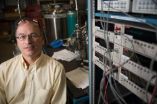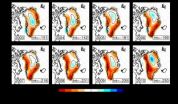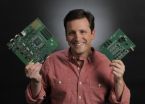Rocks, water, air, space ... and humans: An NSF recipe for AGU success
2012-11-28
(Press-News.org) The National Science Foundation is suggesting adding a bit of spice to a geophysical scientist's research recipe of rocks, water, air, space and life:
Humans.
At next month's Fall Meeting of the American Geophysical Union (AGU) a behemoth of a conference of nearly 20,000 Earth and space scientists, educators, students and policy makers, an international group of scientists will make the case for adding the human element to their research.
The International Network of Research in Coupled Human and Natural Systems – CHANS-Net – is supported by the National Science Foundation's Dynamics of Coupled Natural and Human Systems (CNH) program.
The coupled human and natural systems (CHANS) approach means gaining a broader, more holistic understanding of the crucial questions of sustainability. Looking at ways for both the environment and people to thrive is at the core of CHANS, said Jianguo "Jack" Liu, principal investigator of CHANS-Net and Rachel Carson Chair in Sustainability at Michigan State University.
Bringing CHANS-Net to AGU – Dec. 3-7 in San Francisco -- is planting the seeds of ideas about ways to take research to a new level and is offering help finding collaborators who can help open those doors.
CHANS-Net is some 1,100 members strong across the globe – natural scientists, engineers, social scientists and economists and many others. The nexus is a website, CHANS-Net.org, which has searchable databases to locate potential collaborators, as well as some 500 scientific papers.
And there are also funding possibilities. This year alone, NSF awarded $17.6 million in CNH funding.
"AGU presentations focusing on coupled natural-human systems research will provide geoscientists with insights into the ways that social and behavioral science can complement biophysical science to give fuller, more complete, and more useful new insights into a broad range of environmental issues," said Tom Baerwald, NSF CNH program director.
To familiarize the AGU members with the possibilities of coupling human and natural systems, CHANS-Net is helping to organizing and supporting oral and poster sessions that showcase examples of what can be achieved by casting a wider research net.
There also will be a town hall meeting 12:30-1:30 p.m. Tuesday, Dec. 4, called "Engaging with Coupled Human and Natural Systems." Liu and Baerwald will give overviews of the program, and two researchers will talk about their experiences, and rewards, of mixing human and natural systems.
"For some researchers, this sort of work may seem unfamiliar, but the possibilities are exciting, the support for it is gratifying, and the payoff can be remarkable advances in sustainability," Liu said. "This is a tremendous group of scientists, one that always is looking for more partners to tackle the world's big challenges
INFORMATION: END
ELSE PRESS RELEASES FROM THIS DATE:
2012-11-28
LEXINGTON, Ky. (Nov. 27, 2012) -- Digoxin, a drug widely used to treat heart disease, increases the possibility of death when used by patients with a common heart rhythm problem − atrial fibrillation (AF), according to new study findings by University of Kentucky researchers. The results have been published in the prestigious European Heart Journal, and raises serious concerns about the expansive use of this long-standing heart medication in patients with AF.
UK researchers led by Dr. Samy Claude Elayi, associate professor of medicine at UK HealthCare's Gill Heart ...
2012-11-28
LA JOLLA, CA – November 27, 2012 – Researchers at The Scripps Research Institute (TRSI) are fueling the future of cancer treatment by improving a powerful tool in disease defense: the body's immune system. By revealing a novel but widespread cell signaling process, the scientists may have found a way to manipulate an important component of the immune system into more effectively fighting disease.
The study, recently published online ahead of print by the journal Blood, shows that disabling a particular enzyme, called ItpkB, in mice improves the function of a type of immune ...
2012-11-28
By using common materials found pretty much anywhere there is dirt, a team of Michigan State University researchers have developed a new thermoelectric material.
This is important, they said, because the vast majority of heat that is generated from, for example, a car engine, is lost through the tail pipe. It's the thermoelectric material's job to take that heat and turn it into something useful, like electricity.
The researchers, led by Donald Morelli, a professor of chemical engineering and materials science, developed the material based on natural minerals known ...
2012-11-28
VIDEO:
Princeton University researchers developed an enhanced approach to capturing changes on the Earth's surface via satellite that could provide a more accurate account of how geographic areas change as a...
Click here for more information.
An enhanced approach to capturing changes on the Earth's surface via satellite could provide a more accurate account of how ice sheets, river basins and other geographic areas are changing as a result of natural and human factors. ...
2012-11-28
Toronto, ON (27 November, 2012) -- A new method of growing cardiac tissue is teaching old stem cells new tricks. The discovery, which transforms aged stem cells into cells that function like much younger ones, may one day enable scientists to grow cardiac patches for damaged or diseased hearts from a patient's own stem cells—no matter what age the patient—while avoiding the threat of rejection.
Stem cell therapies involving donated bone marrow stem cells run the risk of patient rejection in a portion of the population, argues Milica Radisic, Canada Research Chair in ...
2012-11-28
Parents may have some new motivations to serve their kids vegetables. A new Cornell University study, published in Public Health Nutrition, found that by simply serving vegetables with dinner, the main course would taste better and the preparer was perceived to be more thoughtful and attentive.
"Most parents know that vegetables are healthy, yet vegetables are served at only 23% of American dinners," said lead author Brian Wansink, PhD, the John Dyson Professor of Marketing and Consumer Behavior at Cornell University. "If parents knew that adding vegetables to the plate ...
2012-11-28
Boulder, Colo., USA – GSA Bulletin articles posted online between 2 October and 21 November span locations such as the San Andreas fault, California; Tibet; Mongolia; Maine; the Owyhee River, Oregon; the Afar Rift, Ethiopia; Wyoming; Argentina; the Sinai Peninsula, Egypt; British Columbia; the southern Rocky Mountains; Scandinavia; and Saturn's largest moon, Titan. Topics include the "big crisis" in the history of life on Earth; the structural geology of Mount St. Helens; and the evolution of a piggyback basin.
GSA Bulletin articles published ahead of print are online ...
2012-11-28
A NASA study using TRMM satellite data revealed that the year 2010 was a particularly bad year for landslides around the world.
A recent NASA study published in the October issue of the Journal of Hydrometeorology compared satellite rain data from NASA's Tropical Rainfall Measurement Mission (TRMM) to landslides in central eastern China, Central America and the Himalayan Arc, three regions with diverse climates and topography where rainfall-triggered landslides are frequent and destructive hazards to the local populations.
The work, led by Dalia Kirschbaum, a research ...
2012-11-28
It's a digital world. Or is it?
NASA technologist Jonathan Pellish isn't convinced. In fact, he believes a computing technology of yesteryear could potentially revolutionize everything from autonomous rendezvous and docking to remotely correcting wavefront errors on large, deployable space telescope mirrors like those to fly on the James Webb Space Telescope.
"It's fast forward to the past," Pellish said, referring to an emerging processing technology developed by a Cambridge, Mass.-based company, Analog Devices Lyric Labs.
So convinced is he of its potential, Pellish ...
2012-11-28
Tropical storm warnings are in effect in Micronesia as NASA and other satellite imagery indicates that Tropical Storm Bopha continues to intensify.
The Atmospheric Infrared Sounder (AIRS) instrument that flies aboard NASA's Aqua satellite captured an infrared image of Tropical Storm Bopha on Nov. 27 at 0241 UTC that indicated a lot of power exists in the strengthening tropical storm. The AIRS image captured the eastern half of the tropical storm and showed a large area of very cold, very high cloud tops, where temperatures colder than -63 Fahrenheit (-52 Celsius) have ...
LAST 30 PRESS RELEASES:
[Press-News.org] Rocks, water, air, space ... and humans: An NSF recipe for AGU success








